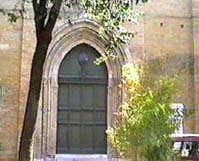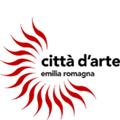Basilica Santuario di San Pellegrino Laziosi
 The construction of this church dates back to XII century. It has
been extensively changed between the XVII and the XVIII century.
The beautiful terracotta portal (XIII cent.)is the only part
belonging to the ancient church.
The construction of this church dates back to XII century. It has
been extensively changed between the XVII and the XVIII century.
The beautiful terracotta portal (XIII cent.)is the only part
belonging to the ancient church.
Address: Via G. Mercuriali, 1, 47121 Forlì (FC),
Italia
Telephone number: +39.0543.34245
Fax: +39.0543.25643
Admission: free
How to get there
It is easy to reach by car or by bus. Leaving on foot from Piazza Saffi, go along Corso Della Repubblica, then turn right in via Flavio Biondo.
Analytical text
The external stone and brick portal is the only structure
belonging to the ancient ''Santa Maria dei Servi' Church built up
during the last quarter of the XIII century by the 'Servi di Maria'
congregation. The portal is in Paden-Gothic style characterized by
a sequence of little columns ending with a series of pilasters
supporting the heavy ogive. An important renovation started during
the XVI century but the total reconstruction of the church dates
back to the first half of the XVII century; it ended around 1750.
The XVIII century interiors contrast with its terracotta
façade. It has a basilica structure with a nave and two
aisles divided by pilasters. In the contra-façade on the
right side there is Monumento funebre a Luffo Numai - Luffo
Numai's memorial (1502) sculpted by Tommaso Fiamberti and Giovanni
Ricci; Luffo Numai was a famous literate and a politician.
On the first altar on the right there is "La Madonna Della Ghiara"
painted by Passignano. On the left there is the XVIII century S.
Pellegrino's chapel enriched by colourful marbles and inspired by a
project by Giuseppe Merenda. The XV century wooden choir is an
important work of art.
"Sala del Capitolo" is the only Late Middle Age structure left. It
was mentioned in a document dated back to the beginning of the XIV
century. It was described as it is nowadays with its rectangular
base over-hanged by a vault and brick corbels.
"La Crocifissione" was painted by Giuliano da Rimini in 1303 and
was restored for the first time around 1500 maybe by Marco
Palmezzano. Recently, it has been restored again. The fragments of
the group of XVI century frescos belong to Livio Agresti's
school.
Services in Basilica
From 8.00am to 11.45am and from 3.00pm to 6.30 pm
The Saint
In the main square of Forlì, a friar named Filippo
Benizi, who was the general prior of the Order of Friar Servants of
Mary, prompts people to abide with the precepts of Pope Martin IV,
after the rebel city interdiction on March 26, 1282. Pellegrino
Laziosi, a young noble man, is among the dissenters. Uneasiness und
remorse then come to the fore. He runs after Filippo Benzi on the
via Emilia and once he has reached by the river Ronco, he throws
himself at the friar's feet asking for forgiveness. When Filippo
embraces him, Pellegrino undergoes a radical change.
The friar Filippo Benzi himself welcomes him to the order in Siena.
There he meets two friars from Siena, blessed Giocchino and blessed
Francesco, who lay the foundation for Pellegrino's santity.
Around 1295 Pellegrino went back from Siena to his home town,
Forlì, where he spent his life praying, doing penance and
helping the poor and then died.
A revealing episode took place around 1325, when he was almost
sixty years old. A painful gangrene to the right hand leg became so
serious that the friary physician, Paolo Salaghi, had to amputate
the sore limp. During the night before the operation, Pellegrino
made it with difficulty to the large Crucifix located inside the
room and there, he besought Jesus to heal him. While he was
half-asleep, he saw Jesus touching his sore leg and he was
instantly healed. This event showed the sanctity of the humble
friar of the Servants of Mary, everybody rushed to. History has it
that such a large crowd of people came to pay their tributes to him
upon communication of his death in 1345 that the doors of the city
could not be shut. His body was exposed in the choir of the church:
everybody wanted to get close and touch the body with objects and
relics. Among the people, a blind person was asking for help and it
seems that Pellegrino woke up and healed him instantly. A woman
possessed by the devil was delivered.
The cult of Pellegrino Laziosi was then approved of in 1609 by Pope
Paul V, who beatified him. Once the canonization procedure had been
complied with, Pope Benedict XIII made him saint in 1726.
Every year on May 1st, it is celebrated S. Pellegrino feast. It is
the cedar feast; in fact the pharmacological properties of this
fruit made it become the symbol of this saint famous for his
therapeutic virtues.
Torna indietro
Comune di Forlì - Piazza Saffi, 8 47121 Forlì
PEC: comune.forli@pec.comune.forli.fc.it - P.Iva: 00606620409
A cura della Redazione di Turismo Forlivese, Piazza Saffi 8, 47121 Forlì - iat@comune.forli.fc.it - Tel. 0543 712362














